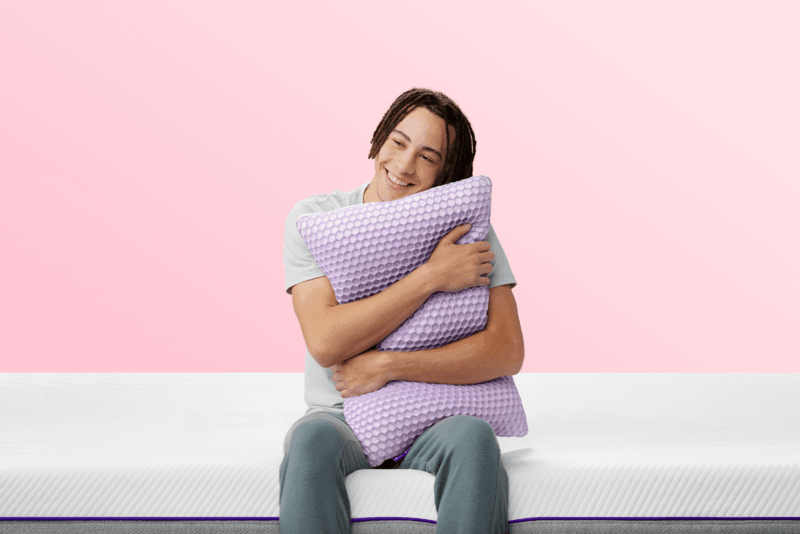Down vs. Feather Pillows: What Are They and Which One Should You Get?
The main difference between down and feather pillows is the filling: feather pillows are made from quill-containing feathers from the wings and backs of birds, while down pillows are compromised of quill-less feather clusters from the underbelly and chest of geese and ducks.
Pillows have a similarly basic design: an outer fabric shell and a soft filling. The stuffing may be down, feathers, wool, cotton, or synthetic material. Down and feathers are both exceptionally soft and can retain warmth naturally. However, down and feathers are not the same.
The distinctions are important because you may need to choose between down and feather pillows, and each one offers different traits. Down is one of the most time-tested, natural options. Unlike feathers, it is a quill-free, puffy material that comes from the underside of ducks or geese.
While your mattress provides support for your body, your pillow has the important job of holding your head and neck. A quality pillow ensures comfort, and it also helps with the alignment of the rest of your body. How well you sleep on your pillow depends on the material used to fill it as well as your sleep position.
Is a down pillow or a feather pillow the right option for you? Quality pillows can be pricey, so it is essential to understand the benefits and alternatives before you invest. Here is what you need to know about down and feather pillows.
What Is a Down Pillow?
Down is a soft feather-like filament that comes from waterfowl. Ducks, geese, and swans have this coating under their exterior feathers. Unlike other feathers, however, it does not have stiff quills, so it is ideal for pillows and other bedding. For example, some duvets have down filling, and the material is also common in comforters.
Down serves as insulation for birds, and it provides the same properties for pillows, blankets, and even jackets. These products often have an outer shell and interior pockets or a quilted design to keep the fluffy down from bunching.
Down vs. Down Alternative
“Down alternative” refers to synthetic filling materials made from polyester microfibers. The goal of these products is to mimic down’s properties.
These pillows usually rely on hypoallergenic materials such as cotton, rayon, and synthetic fibers. Consumers who do not purchase animal products or who are allergic to down can use these pillows. Compared to down, down alternative fillings are typically more affordable, so those on a tight budget can get some of the properties of down for a lower price.
Down pillows come at a much higher price point, but can hold some advantages over synthetic alternatives. Down is naturally more breathable. Alternatives often need to be heavier and denser to offer the same level of warmth. This density can also make synthetic options firmer than the always-soft down. Furthermore, depending on the manufacturer, down tends to last longer than polyester.
Purple Down-Alternative Pillows
Purple offers down-alternative pillows that are made to mimic down and feather pillows at a much more affordable cost. Providing cloud-like comfort with hypoallergenic, ultra-fine gel fibers that won't clump, trap heat or flatten over time.

The Differences Between Down and Feather Pillows
Temperature, fluffiness, and overall softness are the key differences between down and feather filling for pillows. Down and feathers both come from waterfowl.
Feathers, which are soft but have hard quills in the middle, come from the outside of the bird. Down is the layer underneath the feathers. Since it is used for insulation, not flight, it does not need the support of quills, so it is entirely soft.
Feathers are not as soft as down, and they lack the full insulative properties of down. This factor may be a positive one if you live in a warm climate and prefer a cooler pillow.
However, down is softer and has a three-dimensional shape, so it provides more cushion and loft than firmer, flatter feathers. Also, down has more “fill power,” which is the measurement for insulation in pillows. This means that it traps more insulative air pockets because of its fluffy consistency. However, this means that down pillows can trap and hold moisture easily, so washing down pillows presents more of a challenge when it comes to drying them thoroughly and preventing mold growth inside the pillow.
Goose vs. Duck
These two waterfowl are the most common sources for both down and feather filling for pillows.
Geese are larger birds than most ducks, and geese raised for down are often more mature than duck alternatives. Due to their greater size, goose down can be somewhat larger and denser as well, providing better fill power and fluff than duck down.
Ducks also have a more diverse diet than their goose cousins, who are strict herbivores. Some sensitive individuals may detect a slight difference in odor due to these dietary differences, although both types of down and feathers should be thoroughly sanitized before they are used in pillows.
How Long Do Down Pillows Last?
Down is durable, and many pillows with this type of filling are machine washable. However, you should always follow the instructions on the label for appropriate washing. You can wash a down pillow every few months to clean the dust and residue from perspiration or natural body oils.
Down pillows typically last for three years, though the longevity may vary depending on the quality and how you care for it. Feather pillows tend to lose supportiveness in two years or less. In addition to washing the pillow at regular intervals, you should also cover your pillow with a case and, if needed, a hypoallergenic covering that will keep dust and other unwanted substances from getting absorbed in the pillow.
Quality pillows will typically last longer than average. If you notice visible stains that don't wash out or experience a headache or sore neck in the morning, it may be time to replace your pillow. However, if the pillow is still providing comfort and support, then there is no need for a replacement.
Are Down Pillows or Feather Pillows Best?
Down is typically known for its insulative properties, light weight, and fluffiness, which makes it generally more popular than feather pillows. However, both down and feathers are a natural, biodegradable material, and do not contribute to polluting the environment whatsoever. Because they’re made of natural fibers, neither down nor feather pillows are hypoallergenic. Similarly, because down and feather are both animal products, some people may have ethical objections to using them.
Advantages of Down Pillows
The benefits of down include extreme softness. This quality also allows the pillow to contour to the natural shape of your head and neck to provide a high level of support. Other advantages include:
- Warmth — Down is a naturally insulating material that will provide warmth to your head and neck, even though these areas are typically not covered by a blanket.
- Breathability — Down allows more airflow than most other filling materials, including feathers. Even though it is warm, you will be less likely to sweat or feel clammy.
- Durability — If cared for correctly, down pillows can last longer than other products.
- Softness — Down is among the softest pillow fillings available, and unlike feathers it contains no quills or other hard or sharp surfaces.
Drawbacks of Down Pillows
Down is a popular and well-known material, but it does have some drawbacks that you need to be aware of compared to feather pillows and other types of filling.
Some of the drawbacks associated with down pillows include:
- Lack of support — As a result of their softness and lightness, down pillows will continue to sink around the contours of your head. For people who need more support than usual, this could lead to neck pain. Feathers tend to be stiffer and compact, and may be able to provide more support than down.
- Cleaning — While down and feather pillows are both washable, the fluff and shape of down can cause it to hold more moisture after washing, making it difficult to thoroughly dry compared to feather pillows.
- Potential lumpiness — Oil and moisture from your body could cause the down to clump unnaturally in the long term.
- Need fluffing — Down pillows require “fluffing up” after each use. This step replenishes the air within the pad.
Shopping for the Best Pillows
When shopping for a pillow, you need to consider several factors. These include the price, thickness, support, fill materials, and level of support. You will then pick the best pillow based on your needs.
- Price — Quality down pillows are expensive, while a down alternative may be cheaper. A quality synthetic pillow will offer many of the benefits of down at a lower cost
- Washability — You will want to read the label so that you know the cleaning requirements. Down and feather pillows can sometimes carry a slight natural odor even after cleaning, though many people get used to it or find it dissipates over time.
- Loft and firmness — Your preferences and sleeping position can help you decide how much thickness and firmness you need in your pillow.
- Size — Typically, you can match the pillow size with your bed size (king, queen, full, twin). However, people who use more than one pillow may want a smaller one for the top layer.
For some people with feather allergies, down is out of the question. They can instead opt for a latex pillow or another hypoallergenic option.
The Benefits of Purple Pillows
Purple Harmony Pillow
The Purple Harmony™ Pillow offers head and neck support with airflow design to keep you cool.
The Purple Pillow
The Purple Pillow® brings new age comfort science for cool ergonomic support.


